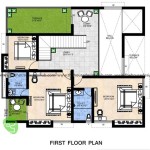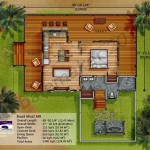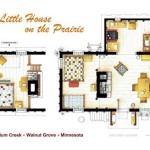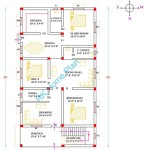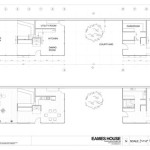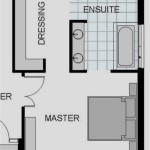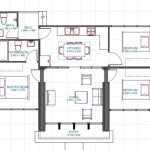Richard Neutra Kaufmann Desert House Plans
The Kaufmann Desert House, designed by renowned architect Richard Neutra, stands as an iconic example of mid-century modern architecture. Located in Palm Springs, California, the house was commissioned by Edgar J. Kaufmann, the same department store magnate who commissioned Frank Lloyd Wright's Fallingwater. Completed in 1946, the Kaufmann Desert House embodies the principles of Desert Modernism, seamlessly integrating with its desert landscape.
Neutra's design philosophy centered around creating a harmonious relationship between the built environment and the natural world. He referred to this as "biorealism," emphasizing the importance of connecting occupants with the surrounding environment for their physical and psychological well-being. The Kaufmann Desert House exemplifies this principle, blurring the lines between interior and exterior spaces.
The house's horizontal lines, expansive glass walls, and open floor plan create a sense of spaciousness and transparency. These features allow for uninterrupted views of the surrounding desert landscape, bringing the outdoors in. The use of natural materials, such as stone and wood, further reinforces the connection to the environment.
The floor plan is organized around a central living area, which flows seamlessly into the dining area and kitchen. This central space serves as the heart of the home, providing a gathering place for family and guests. The bedrooms are located on the periphery of the plan, offering privacy and tranquility.
The meticulously designed outdoor spaces are as important as the interior spaces. Patios, terraces, and a swimming pool provide ample opportunities for outdoor living and entertaining. The pool, famously positioned to reflect the San Jacinto Mountains, becomes an integral part of the overall design. Careful placement of landscaping elements, including cacti and native plants, further integrates the house with the desert environment.
Original plans for the Kaufmann Desert House reveal Neutra's meticulous attention to detail. These plans showcase not only the layout of the house but also the specific materials and finishes selected by the architect. The plans demonstrate Neutra’s commitment to incorporating passive cooling strategies, essential for the desert climate. Overhangs, strategically placed windows, and natural ventilation minimize the need for artificial cooling.
The Kaufmann Desert House has undergone several renovations and restorations throughout its history. After falling into disrepair in the later part of the 20th century, the house was meticulously restored in the 1990s by Marmol Radziner + Associates, adhering to Neutra's original plans and vision. This restoration ensured the preservation of this architectural masterpiece for future generations.
The influence of the Kaufmann Desert House on residential architecture is undeniable. The house's horizontal lines, open floor plans, and integration with the landscape have become hallmarks of Desert Modernism and continue to inspire architects today. Many contemporary desert homes incorporate elements inspired by Neutra's design, demonstrating the enduring legacy of this iconic structure.
Accessing original or reproduced copies of the Kaufmann Desert House plans can provide valuable insights into Neutra's design process. Architectural archives, museums, and specialized publications often hold collections of architectural drawings, including those of the Kaufmann Desert House. Studying these plans allows for a deeper understanding of the architectural principles and design decisions that shaped this landmark building.
The Kaufmann Desert House represents a significant contribution to architectural history. It showcases Neutra's innovative approach to residential design and his commitment to creating harmonious living environments. The house stands as a testament to the power of architecture to connect individuals with the natural world and enhance their quality of life. The lasting impact of the Kaufmann Desert House on architectural trends and its continued relevance in contemporary design solidify its place as a true architectural masterpiece.
The design of the Kaufmann Desert House remains a topic of study for architecture students and enthusiasts alike. Its careful consideration of climate, its innovative use of materials, and its seamless blending of indoor and outdoor spaces offer valuable lessons for contemporary architects seeking to create sustainable and aesthetically pleasing residential designs. The house serves as a reminder of the importance of integrating architecture with the surrounding environment, a principle that remains relevant in today's world.
The use of steel framing, combined with concrete floor slabs, allowed Neutra to create the expansive open floor plan that characterizes the house. This construction method also provided structural stability in the desert environment. The choice of materials, from the stone used for exterior walls to the wood used for interior finishes, was carefully considered to complement the natural surroundings and create a cohesive design.
The iconic status of the Kaufmann Desert House extends beyond architectural circles. It has been featured in numerous films, television shows, and publications, cementing its place in popular culture. This widespread recognition reflects the enduring appeal of its design and its significance as a cultural landmark.

Richard Neutra Kaufmann Desert House Palm Springs 1946 1947 Plan Scientific Diagram

Kaufmann Desert House Ground Floor Plan Plans Search

Ad Classics Kaufmann House Richard Neutra Archdaily

Kaufman Desert House Floor Plan Mimari çizimler Maket

Ad Classics Kaufmann House Richard Neutra Archdaily

Gallery Of Ad Classics Kaufmann House Richard Neutra 14

Kauffman Desert House By Richard Neutra Homes Kaufman

Browse All Architecture By Neutra 2c Richard From Modernist Ncsu Libraries Collections

Coloring A Plan Layout Usonian House Plans Family

Kaufmann Desert House Palm Springs 1946 Richard Neutra Scientific Diagram

